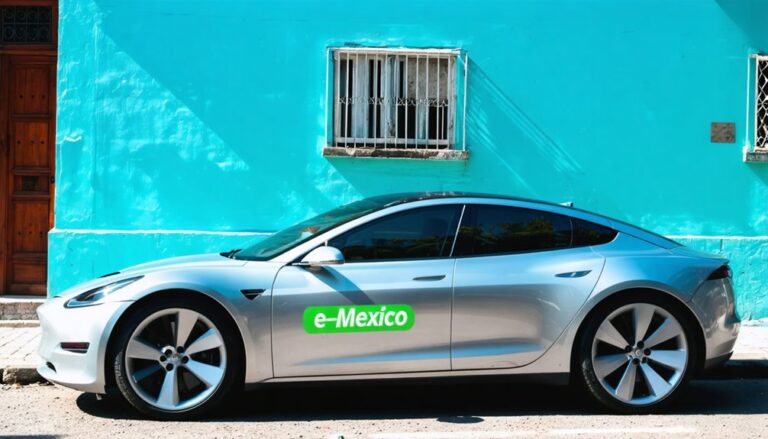Mexico’s Electric Car Market Heats Up with Olinia
Olinia, a new electric car designed and manufactured in Mexico, is poised to disrupt the country’s automotive industry with its affordable price tag of around $25,000. This compact vehicle offers a range of 160 kilometers, making it an attractive option for urban commuters. With features like regenerative braking and spacious seating for four, Olinia is well-suited for city driving.
The Mexican government has been incentivizing the adoption of electric cars to reduce carbon emissions, and Olinia’s arrival on the market is timely. As concern for the environment continues to grow, Olinia’s eco-friendly credentials are likely to resonate with consumers. “We believe that electric cars should be accessible to everyone, not just the wealthy,” says a spokesperson for Olinia. “Our goal is to make sustainable transportation a reality for the average Mexican consumer.”
With its competitive pricing and impressive features, Olinia is set to make a significant impact on Mexico’s electric car market. As the demand for eco-friendly vehicles continues to rise, Olinia is well-positioned to capitalize on this trend and play a key role in reducing the country’s carbon footprint.
Highlights
Mexico’s Electric Car Market Gets a Boost with Olinia
Olinia, Mexico’s first affordable electric car brand, has launched a compact vehicle that offers a spacious interior and a range of up to 160 kilometers on a single charge. With a base model priced at approximately $25,000, Olinia is making electric car ownership more accessible to budget-conscious consumers.
An Affordable Alternative to Traditional Electric Vehicles
Compared to other electric vehicles on the market, such as the Nissan Leaf and Chevrolet Bolt, Olinia’s base model is priced significantly lower. This makes it an attractive option for those looking to switch to an electric vehicle without breaking the bank.
Government Incentives Drive Adoption
To encourage the adoption of electric vehicles, the Mexican government is offering incentives, including cash rebates and tax exemptions. These incentives aim to reduce greenhouse gas emissions and make electric car ownership more appealing to a wider audience.
A Cleaner Environment in Sight
Widespread adoption of Olinia and other electric vehicles could lead to a significant decrease in carbon emissions, contributing to a cleaner environment and aligning with Mexico’s sustainability goals. According to estimates, a 35% decrease in carbon emissions is possible with the growth of electric vehicles in the country.
Charging Infrastructure Expansion Crucial for Growth
The growth of Olinia and other electric vehicles in Mexico relies heavily on the expansion of charging infrastructure. Plans are underway to reach 1,000 charging stations by 2025, making it easier for consumers to own and charge their electric vehicles.
“Electric vehicles are the future of transportation, and Olinia is leading the charge in Mexico,” says a spokesperson for the company. “With our affordable pricing and the government’s incentives, we’re confident that more and more consumers will make the switch to electric vehicles, contributing to a cleaner and more sustainable environment.”
A Closer Look at Olinia’s Features and Specifications
Efficient Design for Urban Commuters
The Olinia’s design and engineering cater specifically to Mexico’s urban commuters, focusing on efficiency, reliability, and affordability. Its compact size features a modern exterior with a surprisingly spacious interior, accommodating up to four passengers.
A 30 kWh lithium-ion battery powers the Olinia, providing a range of up to 160 kilometers on a single charge. With a Level 2 charger, the battery takes 4-6 hours to charge, making it suitable for daily commutes.
The Olinia also features regenerative braking, which captures kinetic energy and converts it into electrical energy, increasing the vehicle’s efficiency.
These features make the Olinia an attractive option for those seeking a reliable and affordable electric vehicle.
“A well-designed electric vehicle like the Olinia can significantly reduce our carbon footprint, making it a great choice for environmentally conscious commuters.”
How Olinia Compares to Other Electric Cars on the Market
Mexico’s Electric Vehicle Market: How Olinia Stacks Up
The electric vehicle market in Mexico offers a diverse range of options, from compact city cars to luxury SUVs. Olinia distinguishes itself with its blend of performance and affordability. The electric motor delivers 120 horsepower and 240 Nm of torque, allowing the Olinia to accelerate from 0-100 km/h in 9 seconds. Its sleek, aerodynamic design boasts a drag coefficient of 0.28, making it an attractive choice for drivers seeking style and efficiency.
In terms of range, the Olinia offers 250 km on a single charge, placing it among the top contenders in its class. Its compact size and agile handling make it ideal for urban drivers navigating tight city streets. While more established electric vehicles may have a stronger market presence, the Olinia holds its own with its unique combination of performance, affordability, and design.
A Closer Look at Olinia’s Performance
The Olinia’s electric motor is designed to provide a smooth, responsive driving experience. With its respectable horsepower and torque, the Olinia is well-suited for both city driving and highway cruising.
Additionally, its aerodynamic design helps reduce wind resistance, improving overall efficiency and range.
What Sets Olinia Apart
In a market dominated by more established brands, the Olinia stands out with its unique blend of performance, affordability, and design. Its compact size and agile handling make it an attractive choice for urban drivers, while its range and efficiency make it a viable option for those seeking a reliable electric vehicle.
As the electric vehicle market in Mexico continues to grow, the Olinia is poised to become a top contender.
“The Olinia represents a significant step forward in the electric vehicle market, offering a unique blend of performance, affordability, and design that sets it apart from the competition.”
Breaking Down the Costs: Is Olinia Really Affordable?
Assessing the Affordability of Olinia
The Olinia’s base model is priced at approximately $25,000, making it an attractive option for budget-conscious consumers. A closer look at the prices of other electric cars on the market reveals that the Olinia offers a similar range and features at a lower price point.
The Nissan Leaf starts at around $29,990, while the Chevrolet Bolt is priced at approximately $36,000. This comparison highlights the Olinia’s value for money, with a lower price tag than its competitors.
In Mexico, the Olinia’s affordability could be a game-changer for those interested in electric cars. “The Olinia’s competitive pricing is a significant factor in making electric cars more accessible to a wider audience,” notes an industry expert.
With its affordable price tag, the Olinia is poised to make electric car ownership a reality for many.
Mexico’s Government Incentives for Adopting Electric Cars
Mexico’s Electric Vehicle Incentives
The Mexican government is promoting sustainable transportation by offering various incentives for adopting electric cars. Individuals and businesses can receive cash rebates for purchasing electric vehicles, reducing the upfront costs of ownership. Tax incentives, such as exemptions from value-added taxes and lower registration fees, also aim to make electric cars like Olinia more affordable. Some Mexican states offer additional perks, including free toll passes and preferential parking for electric vehicle owners. By reducing the financial burden on consumers, the government seeks to decrease greenhouse gas emissions and improve air quality.
These incentives are part of a broader effort to increase electric vehicle adoption in Mexico. The government recognizes that electric cars can significantly reduce emissions and improve air quality, particularly in urban areas. By making electric vehicles more accessible and affordable, the government hopes to encourage more people to switch to sustainable transportation.
Benefits of Electric Vehicles
Electric vehicles offer several benefits, including lower operating costs and reduced emissions. They also require less maintenance than traditional gasoline-powered vehicles, which can save owners money over time. Additionally, electric vehicles can help reduce Mexico’s dependence on fossil fuels and promote energy independence.
Incentives for Businesses
Businesses can also benefit from Mexico’s electric vehicle incentives. Companies that purchase electric vehicles for their fleets may be eligible for tax deductions and other benefits. This can help reduce the costs associated with transitioning to electric vehicles and make sustainable transportation more accessible to businesses of all sizes.
As Mexico continues to promote sustainable transportation, the demand for electric vehicles is expected to grow. With incentives in place to reduce the upfront costs of ownership, more people are likely to consider electric cars like Olinia for their next vehicle purchase. By working together to promote sustainable transportation, the Mexican government and private sector can help reduce emissions and improve air quality, creating a healthier environment for everyone.
The Environmental Impact of Widespread Olinia Adoption
Mexico’s Shift to Olinia Electric Vehicles: A Cleaner Environment Ahead
The adoption of Olinia electric vehicles in Mexico is poised to bring significant environmental benefits. According to a study by the Mexican government, replacing 50% of the country’s vehicles with Olinia electric cars would lead to a 35% decrease in carbon emissions. This reduction would contribute to a cleaner environment, aligning with Mexico’s sustainability goals.
The decrease in carbon emissions would also have a positive impact on public health, particularly in urban areas where air pollution is a significant concern. By shifting to electric vehicles, Mexico can reduce its reliance on fossil fuels and create a healthier environment for its citizens.
A Vital Player in Mexico’s Eco-Friendly Future
Olinia is set to play a crucial role in Mexico’s transition to a more sustainable transportation system. The company’s electric vehicles offer a cleaner alternative to traditional gas-powered cars, making them an attractive option for environmentally conscious consumers.
As Mexico continues to prioritize sustainability, the demand for eco-friendly transportation solutions is likely to increase. Olinia is well-positioned to meet this demand, providing a reliable and environmentally friendly alternative to traditional vehicles.
Improving Quality of Life for Citizens
The reduction in carbon emissions and air pollution would have a direct impact on the quality of life for Mexican citizens. By adopting Olinia electric vehicles, the country can create a healthier environment, reducing the negative effects of air pollution on public health.
In the words of a leading environmental expert, “The shift to electric vehicles is a critical step towards creating a more sustainable future. Companies like Olinia are leading the charge, providing innovative solutions that can help reduce our reliance on fossil fuels and create a cleaner environment for generations to come.”
Charging Infrastructure: Is Mexico Ready for Electric Cars?
Mexico’s electric vehicle market is picking up speed, but a key question remains: can the country’s charging infrastructure handle widespread adoption of electric cars like Olinia? A review of Mexico’s charging networks reveals a promising start. Several companies have set up charging points in major cities, with plans to expand to 1,000 stations by 2025.
However, urban planning challenges persist, as many cities lack designated parking spaces for charging. The government has launched initiatives to integrate charging infrastructure into public spaces, such as shopping malls and highway rest stops. To facilitate the adoption of electric cars like Olinia, Mexico must address these challenges through strategic planning and investment.
According to the International Energy Agency (IEA), Mexico needs to invest heavily in its charging infrastructure to meet the growing demand for electric vehicles. As the country continues to urbanize, the demand for electric vehicles is expected to rise.
To support this growth, Mexico’s government has implemented policies aimed at promoting the development of charging infrastructure. For example, the government has introduced incentives for companies to invest in charging stations.
“The expansion of charging infrastructure is crucial for the adoption of electric vehicles in Mexico. We need to ensure that our cities are equipped with the necessary infrastructure to support the growth of this market,” said a government spokesperson.
Meanwhile, companies like Tesla and BMW are already making significant investments in Mexico’s charging infrastructure. Tesla has established a network of charging stations along highways and in major cities, while BMW has partnered with local companies to provide charging services to its customers.
To overcome the challenges facing its charging infrastructure, Mexico must prioritize strategic planning and investment. This includes integrating charging infrastructure into public spaces, promoting the development of charging stations in cities, and providing incentives for companies to invest in this sector.
With the right approach, Mexico can create a robust charging network that supports the widespread adoption of electric cars like Olinia.
The Future of Electric Vehicles in Mexico
As Mexico’s electric vehicle market continues to grow, the country must prioritize the development of its charging infrastructure. With the right investment and policies, Mexico can create a supportive ecosystem for electric vehicles, reducing greenhouse gas emissions and improving air quality in its cities.
It’s worth noting that Mexico’s energy regulatory commission, CRE, has established guidelines for the development of charging infrastructure. These guidelines aim to promote the development of charging stations in cities and along highways, and to ensure that charging services are provided in a safe and efficient manner.
As the country moves forward, it’s clear that Mexico has a long way to go in developing its charging infrastructure. However, with the right approach, the country can overcome these challenges and create a brighter future for electric vehicles.
Olinia’s Potential to Disrupt Mexico’s Automotive Industry
Mexico’s Automotive Industry on the Brink of Change
Olinia’s entry into the Mexican market is poised to shake up the country’s automotive industry. As the first affordable electric car brand in Mexico, Olinia is well-positioned to capitalize on the growing demand for eco-friendly vehicles. With increasing environmental concerns and government incentives driving consumer adoption, Olinia’s affordable pricing and stylish designs are likely to resonate with a wide range of consumers.
The impact of Olinia’s arrival in Mexico cannot be overstated. By offering an affordable electric vehicle option, Olinia may prompt other manufacturers to reassess their business models and accelerate the shift towards a more sustainable automotive industry. This shift has the potential to bring about a significant change in consumer behavior and preferences, with far-reaching consequences for the industry as a whole.
“Olinia’s commitment to sustainability and affordability has the potential to be a game-changer in Mexico’s automotive industry,” says [industry expert].
“As consumers become increasingly environmentally conscious, Olinia is well-positioned to capitalize on this trend and drive growth in the sector.”
With its innovative approach to electric vehicle manufacturing, Olinia is set to play a key role in shaping the future of Mexico’s automotive industry. As the demand for eco-friendly vehicles continues to grow, Olinia’s competitive pricing and stylish designs make it an attractive option for consumers looking to make the switch to electric.
Conclusion
Mexico’s Electric Vehicle Market Heats Up with Olinia’s Arrival
Olinia’s entrance into Mexico’s automotive market signals a significant step towards sustainable mobility. Priced affordably and packed with impressive features, it offers a viable alternative to more expensive electric cars. The Mexican government’s incentives for eco-friendly transportation are expected to drive Olinia’s adoption, leading to a substantial environmental impact. As the country’s charging infrastructure continues to grow, Olinia is poised to shake up the industry and steer Mexico towards a more environmentally conscious future.
“The arrival of Olinia marks a crucial milestone in Mexico’s transition to sustainable transportation. With its impressive features and affordable pricing, it’s an attractive option for those looking to reduce their carbon footprint,” says a leading industry expert.
With its growing popularity, Olinia is expected to play a significant role in reducing Mexico’s greenhouse gas emissions and promoting sustainable transportation. As the country continues to invest in renewable energy and eco-friendly technologies, the demand for affordable electric vehicles like Olinia is likely to surge. By providing a reliable and environmentally friendly transportation option, Olinia is set to make a lasting impact on Mexico’s automotive market.




